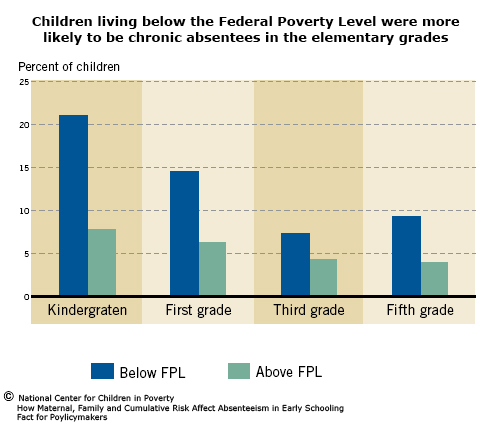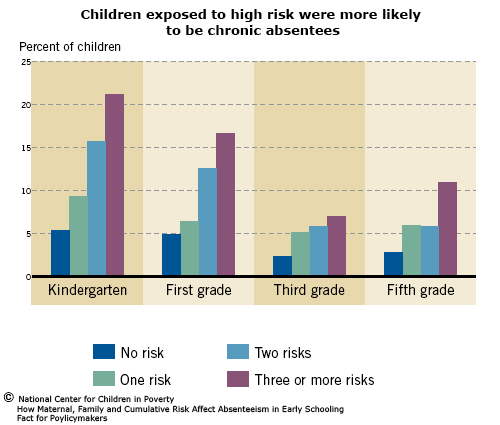What is the role of the schooling experience in the educational trajectories and outcomes of children exposed to risk?
Maternal and family risks are associated with greater absenteeism and the cumulative exposure to risk best predicts chronic absenteeism in early schooling. Kindergarten children in contact with three or more risks missed three or more days than their peers not facing any risks. But as children progress through the elementary grades, the impact of cumulative risk on school attendance lessens, only to rise again in the fifth grade. The most vulnerable children – those who are poor or racial/ethnic minorities or suffer from poor health–have the greatest exposure to cumulative risk.
How Prevalent are Maternal and Family Risks among U.S. Elementary School Children?
The maternal and family risks most commonly encountered by U.S. kindergartners include:
- living with a single mother (19 percent);
- below the Federal Poverty Level (18 percent);
- in a large family – four or more children at home (14 percent); or
- with a mother who has not completed high school (12 percent).
The least frequent risks were being born to a teenage mother (4 percent) or living with an unemployed mother (4.5 percent).
These risks are more persistent among the most vulnerable children – those who were poor, racial/ethnic minorities, or suffered from poor health. A child’s risk status is directly related to family income; the poorer the children, the more they experience any of the risks tracked. For every affluent kindergartner – living at 400 percent of, or above the federal poverty level – who experienced each of the following risks:
- 30 poor children experienced food insecurity at home;
- 20 had a mother with low education;
- 15 had an unemployed mother;
- nine were born to a teenage mother;
- seven lived with a single mother;
- six had a mother with poor health; and
- five lived in a family with four or more children.
Nonwhite children consistently experienced greater risks than their white counterparts. Black children encountered more risks than did Hispanic children, except for low maternal education, which was more common among the latter than among the former. Thus, for every white kindergartner experiencing each of the following risks,
- six black and four Hispanic children had mothers on welfare;
- four black and two Hispanic children lived with a single mother; and
- three black and six Hispanic children had a mother with low education.
For every white kindergartner who experienced each of the following risks,
five children of each nonwhite group lived in poverty;
- three faced food insecurity at home;
- three were born to a teenage mother;
- two had a mother with poor health; and
- two lived in families with a large number of children.
Kindergartners with poor health were more likely to encounter more risks than their healthy peers.
How Do Individual Risk Factors Relate to Early Chronic Absenteeism?
Differences in absences comparing each individual risk, in general, were small, with poverty resulting in four extra days of absenteeism in kindergarten, on average, and food insecurity and welfare receipt resulting in 2.5 additional days of absenteeism in the same grade. These differences were the highest in this grade, and decreased steadily through third grade, reflecting increases in overall attendance observed in early elementary schooling, only to rise again, even if slightly, in fifth grade.
Poverty

Across grades, children living in families below the Federal Poverty Level missed, on average, slightly over one day more than their non-poor peers. In kindergarten, 21 percent of poor children were chronic absentees, compared to nearly 8 percent of their non-poor peers.
Teenage Mother
Children born to teenage mothers were absent over one day more, on average, than those born to mothers older than 18 years. In kindergarten, almost 22 percent of children born to teenage mothers and almost 10 percent of those born to older mothers missed 10 percent or more of the school year.
Single Mother
Children living in mother-only households missed one day more, on average, than children living in two-parent households. Nearly 16 percent of kindergartners living in mother-only households and 10 percent of those living in two-parent households were chronic absentees.
Low Maternal Education
Children whose mothers had less than a high school education missed, on average, almost 1.5 more days of school than those of mothers with a high school education or more. In kindergarten, 22 percent of children of mothers with low education were chronic absentees, compared to 9 percent of those whose mothers had completed at least high school.
Welfare Receipt
Children whose mothers were on welfare during the previous 12 months missed, on average, 1.7 more days of school than their counterparts in the elementary grades. In kindergarten, 25 percent of children whose mothers were on welfare and 9 percent of their nonwelfare peers were chronic absentees.
Unemployment
Children whose mothers were unemployed were absent, on average, over two days more than their counterparts in the elementary grades. In kindergarten, children of unemployed mothers were 2.3 times more likely than their counterparts to be chronic absentees (19 percent versus 8 percent).
Mother with Poor Health
Children whose mothers reported experiencing poor health missed almost two days of kindergarten, on average, than those whose mothers were in good health. They were over twice as likely as their counterparts to be chronic absentees.
Food Insecurity
Kindergartners living in households experiencing food insecurity skipped, on average, over two days more of school than their peers living in food-secure households. Twenty-two percent of kindergartners in food-insecure households were chronic absentees, compared to 9 percent of their peers in food-secure households.
Four or More Children at Home
Kindergartners living in homes with four or more minors missed, on average, one day more of school than their peers in small families. In kindergarten, 15 percent of the former and 9 percent of the latter were chronic absentees.
What is the Incidence of Cumulative Risk among U.S. Children?
- Almost 14 percent of kindergartners experienced high levels of risk;
- 53 percent faced no risk; and
- 23 percent and 10 percent were exposed to one and two risks, respectively.
The proportion of children encountering three or more risks diminished over the grades, reaching 9 percent in fifth grade.
Poor and low income children
Poor and low income children were more likely than their more affluent peers to encounter high risk throughout their elementary school lives.
- 65 percent of poor kindergartners faced three or more risks;
- 9 percent of low income, 7 percent of middle income, and less than 1 percent of affluent peers – (living at 400 percent or above of the federal poverty level) faced three or more risks.
Black and Hispanic Children
On average, black and Hispanic children were, respectively, five and four times more likely than their white peers to be exposed to three or more risks. In kindergarten, 6 percent of white children faced high cumulative risk, compared to 38 percent of black children and over 28 percent of Hispanic children.
Children With Poor Health
Children whose health was poor were three times more likely than their healthy peers to experience three or more risks. Among kindergartners, over 36 percent of children with poor health were exposed to high risk, compared to 13 percent of their healthy counterparts.
How Does Cumulative Risk Relate to Early Chronic Absenteeism?

In general, the greater the exposure to cumulative risk, the greater the absenteeism. Regardless of income- and race/ethnicity-based differences in absenteeism, kindergartners with three or more risks averaged almost three more absences than their peers not exposed to any risk. This difference decreased to two and less than one day, on average, in first and third grade, and rose to over one day in fifth grade.
Children with three or more risks were more likely than their peers without any risks to miss 10 percent or more of the school year. In kindergarten, 21 percent of children with three or more risks were chronic absentees, compared to 5 percent of children without risks. This proportion decreased in both first and third grades, only to increase slightly in fifth grade.
Conclusion
Poverty and other forms of maternal and family risk have a detrimental impact, both singly but particularly in combination, on children’s early formal education experiences. Children vulnerable by virtue of their poverty, racial/ethnic minority, and poor health status experience greater risk than their affluent, white, and healthy peers. Individual risks tend to co-occur in the population studied. Some of these risks – for instance, maternal education – have two-generational implications in that they constitute risks for both children’s development and maternal employment. The findings point to the urgency to identify and provide supports to vulnerable children early in their formal schooling careers in order to steer them toward successful early learning trajectories. They also highlight the need to examine how protective factors – resources, skills, and abilities of parents, families and communities – can help strengthen children’s resiliency in the context of highrisk exposure, and contribute to early school success.
Endnotes
1. The current federal poverty level for a family of 4 is 21,200 in 2008. For more information on measuring poverty, see NCCP’s state profiles at and the U.S. Department of Health and Human Services.
2. Households were identified as experiencing food insecurity if either the child or the adults reduced their food intake, skipped meals, and/or went hungry because of food shortage.
3. For information on statistical tests and levels of significance, see Romero, Mariajosé, & Lee, Young-Sun. (2008). The Influence of Maternal and Family Risk on Chronic Absenteeism in Early Schooling. Report. New York: National Center for Children in Poverty.
4. Teenage mother, unemployment, and large family size were not statistically significant.
5. Absenteeism patterns appeared to differ by whether the household was headed by a single mother or a single father, suggesting that children’s absenteeism was more severe if they lived in father-only households, as opposed to mother-only households. This finding ought to be taken cautiously since in some grades the number of father-only households in the study subset was small. Therefore, the study focused on mother-only households and father-only households were dropped from the analysis.
6. Mothers who reported not being in the labor force at the time of the survey were not included in this analysis. Data on fifth grade are not included because of the very small number of unemployed mothers in this grade.
7. Information on parent’s health was collected only in kindergarten and third grade.
8. Data on food insecurity were not available for 1st Grade.
9. It is important to take into account the higher attrition over time among low income and minority study participants than among higher income and white study participants.
10. By definition, there were no poor children without any cumulative risk, since poverty status was among the risks considered. Eleven percent of kindergartners faced one risk, poverty alone, whereas 24 percent encountered two risks. Income-based differences in exposure to cumulative risk persisted even after poverty status and welfare receipt were excluded: here, 26 percent of poor kindergartners faced three or more risks, compared to 6 percent or low income children, and less than one percent of middle income and affluent kindergartners.
11. Forehand, Rex, & Brody, Gene. (2002). Psychosocial adjustment of African American children in single-mother families: A test of three risk models. Journal of Marriage and Family, 64(1), 105-115.
12. Hair, Elizabeth C., McGroder, Sharon M., Zaslow, Martha J, Ahluwalia, Surjeet K., & Moore, Kristin A. (2002). How do maternal risk factors affect children in low-income families? Further evidence of two-generational implications. Journal of Prevention & Intervention in the Community, 23(1/2), 65-94.
13. Murry, Velma M., & Brody, Gene.H. (1999). Self-regulation and self-worth of black children reared in economically stressed, rural, single mother-headed families. Journal of Family Issues, 20(4), 458-484.
